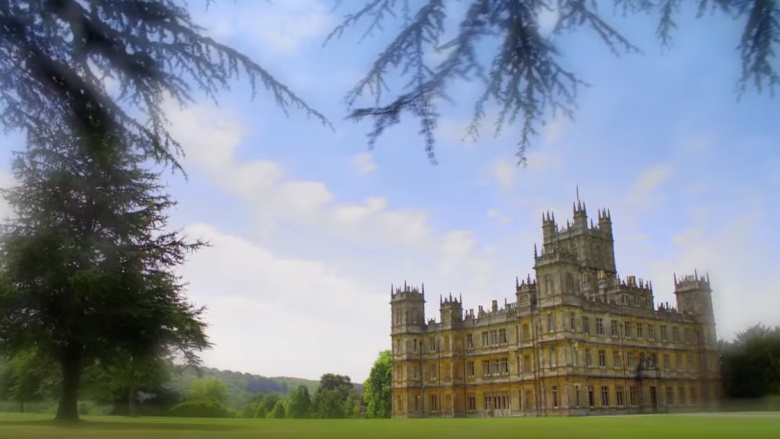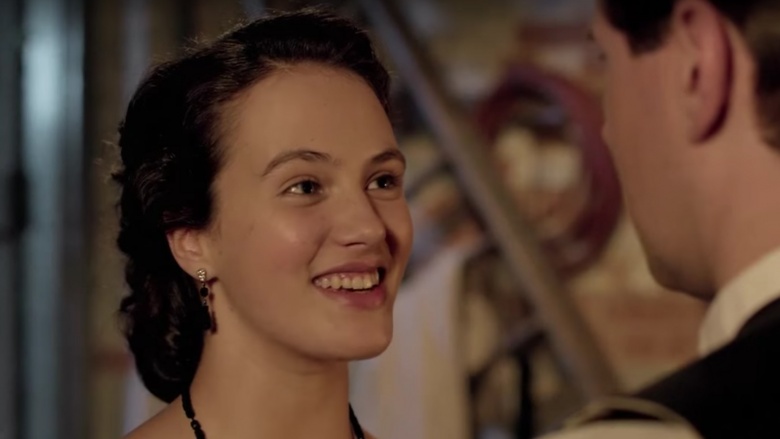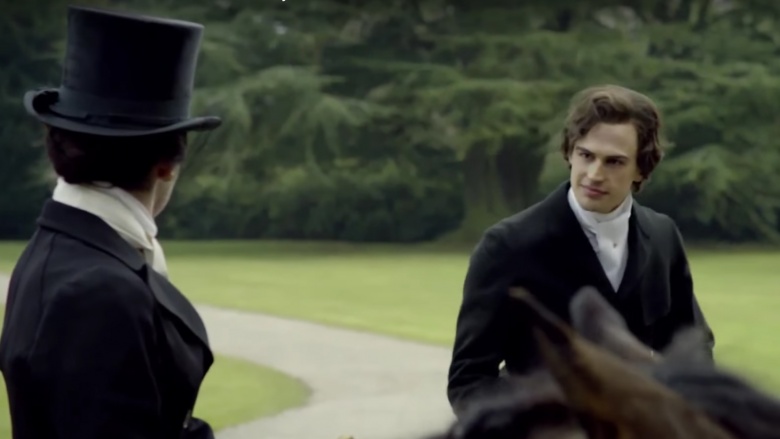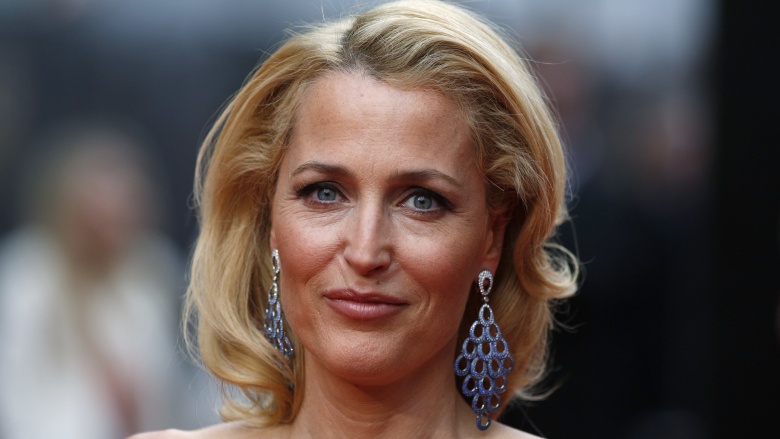The Untold Truth Of Downton Abbey
We may receive a commission on purchases made from links.
For six seasons, the world came together each week to soak in the beauty, grace and nostalgia that was PBS Masterpiece Theater's Downton Abbey. The show offered our collective world-weary souls a respite from the woes of our modern-day world and allowed us to immerse ourselves in an early 20th century existence. It seemed so much simpler, for some reason. We fell in love with the Crawley family and their devoted servants and couldn't wait to discover what would happen next, mourning losses and developing love/hate feelings for characters as if we really lived in their world.
The show became the highest-rated PBS show of all time, and with 69 Emmy nominations and 15 wins, it was obvious the show was a home-run.
It was sad when Downton Abbey was canceled and the final episode aired, but if you're like me, I revisit Downton from time to time to soak in the opulence and relive the best moments of the show. Before you head back to revisit the Crawleys yourself, here are a few things you might not know about the making of the show.
A real family lives in the estate where Downton Abbey is filmed
Much of the series is filmed at Highclere Castle, an estate in Hampshire, England that is home to a real life family headed by the Earl and Countess of Carnarvon. Of course, we are all accustomed to seeing shots of its beautiful exterior in the show, but much of the downstairs of the castle, including the library, dining room, drawing room, and grand hallway can be seen in episodes of Downton Abbey. Most of the scenes featuring the servants quarters, however, are shot at a London studio.
In addition to being open to the public, Highclere Castle can be rented for weddings and parties. There are also some lovely cottages on the estate for rent.
It was costly to film
Depicting all the opulence of the 1920s British aristocracy did not come cheap. From the period costumes — some of them original pieces — to the exquisite sets, to the stellar cast of characters, the show cost a pretty penny to produce.
Jessica Fellowes, the author of The World of Downton Abbey, wrote that the production company spent more than $1 million for each episode.
Structure of Downton Abbey was inspired by an American television series
Surprisingly, the structure for Downton Abbey was inspired by several American television series, including Mad Men, Glee and Sex and the City.
"There are lots of American shows I admire," creator Julian Fellowes told the New York Times in a 2013 interview. "The American series have a tremendous energy which I admire, and I hope I have emulated in Downton. In a way it's a period drama and it has all these stories packed in. That, I think, has much more to do with the American tradition of television than the British, actually. Sometimes these distinctions are meaningless because it becomes absorbed within the culture. But I think the Americans, with West Wing and NYPD Blue and E.R. and Chicago Hope – this tremendously energized, multi-narrative, multi-level show – I think that was a reinvention of television that has affected us all."
The food used in the show is real
One of the pseudo-characters in the show is the food. At some point in each episode, we watch Mrs. Patmore, Daisy and their merry band of cooks concoct scrumptious dishes. We follow the food up the stairs with Mr. Carson and the other footmen; and watch with envy as the Crawley's enjoy their meal, often in the company of the Dowager Countess or other guests. As with other aspects of the production the crew worked tirelessly to recreate, the food used in the show was real.
"Food has been quite good for storylines," Lisa Heathcote, head of all edible props for the show, told Rustik magazine. "A lot of important conversations happen around a meal, so it's a conduit throughout the scenes."
Although Heathcote is not a food historian, she said she garnered an extensive knowledge of the time period and spent a great deal of time researching before each episode went into production. "Often the research is part of the fun," she says. "I find private collections of menus and go off to hotels and things."
Unfortunately for the actors and crew, some of the dishes, particularly culinary delights like lobster and crab, had a less-than-appealing stench by the end of a long day on set.
Dame Maggie Smith has never watched an episode
Dame Maggie Smith, who received five Emmy nominations for her role as the Dowager Countess of Grantham, has confessed that she has never watched an episode of Downton Abbey. The 81-year-old actress said she couldn't bear to watch the show because she would have been obsessed with thoughts of how she could have improved her performance.
”I was just pausing because I've never actually seen it," Smith told CBS's 60 Minutes in 2013, as reported by The Telegraph. "I don't sit down and watch it. No, I've never watched it.”
Smith said at the time that with the end of the show, she might actually sit down and watch the show the world obsessed over. ”I will look at it when it's all over, maybe, because it's frustrating — I always see things that I would like to do differently and think, 'Why in the name of God did I do that?”'
Jessica Brown Findlay (Lady Sybil) trained as a ballet dancer
Before Jessica Brown Findlay stole the hearts of Downton fans as Lady Sybil Grantham, the actress was an accomplished ballet dancer.
Her love for dance began when she was 3 years old. She went on to train with the National Youth Ballet and the Associates of the Royal Ballet and even danced with the Kirov Ballet before an ankle injury sadly ended her career as a dancer.
Heartbroken, Findlay continued to pursue her love of performing arts by taking acting classes and began a career as an actress. Findlay says her years of training as a dancer continues to influence her today.
"I do still have a dancer's mentality, which may be to do with the training," Findlay told The Telegraph. "It gives you a kind of determination, and friends that I trained with – even the ones who haven't gone on to be professional dancers – have it, too. They are extremely focused, very driven people – it just seems to go with the territory."
Findlay is also a talented painter.
The scandal with the Turkish diplomat was based on real events
One storyline from season one that would come to haunt Lady Mary through every season thereafter was the character's romantic interlude with Mr. Pamuk, the Turkish diplomat, which was followed by his death in her bed. It became almost comical as the women of the house, including Mary's mother, Cora, returned his body to his own bed in the middle of the night.
According to the show's creator, Julian Fellowes, the storyline was inspired by a diary entry written by the great aunt of one of his friends, which chronicled a similar story — that of a diplomat secretly entering the room of a single lady for a romantic tryst, only to die in the middle of the night and have to be carried back into his room by the women of the house.
Isis the dog was not killed off because of her name
It was a sad day when Isis, the faithful companion of Lord Grantham, passed away in season five. Because of news of the day concerning the extreme terrorist group of the same name, there was some speculation that the dog was killed off the show because of its name. But, that rumor was put to rest when Hugh Bonneville, who plays Lord Grantham, set the record straight on that matter.
"To clarify recent speculation, the Labrador that appeared in series one (1912-14) was a dog called Pharaoh," wrote Bonneville on his website. "From series two (1916-1920) onwards, the Labrador has been a bitch named — in keeping with the Egyptian theme — Isis. Anyone who genuinely believes the series five storyline (1924) involving the animal was a reaction to recent world news is a complete berk."
Gillian Anderson was offered the part of Cora but turned it down
Former X-Files alum Gillian Anderson was originally offered the role of Cora, the Countess of Grantham, although she reportedly turned it down. Currently starring in the Netflix original series, The Fall, which is set in England, Anderson is a fan favorite of British television audiences and has starred in several Masterpiece period pieces, including 2005's Bleak House and Great Expectations in 2011.
Instead of Anderson, the role eventually went to American actress Elizabeth McGovern.
Queen Elizabeth is a fan but likes to point out the errors
Some members of the royal family, including the Duke and Duchess of Cambridge, are huge fans of Downton Abbey. Even Queen Elizabeth has confessed to being a fan of the show, although she seems to get a lot of satisfaction out of pointing out the errors she finds in the show.
"She loves to pick out the mistakes," At Home with the Queen author Brian Hoey told People magazine. Despite the fact that the show has a historical consultant to ensure the show adheres to way of life for the 1920s British aristocracy, the queen apparently enjoys combing through the episodes to locate the rare mistake.
"They do tend to get it right," Hoey said of the series' producers. "However, the Queen did notice on one episode that there was a young so-called British officer wearing medals which had not been awarded when he was supposed to be alive. He was fighting in the First World War and the medals on his chest did not come in until the Second World War."










